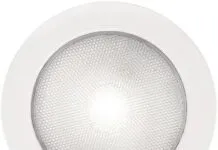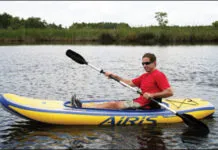Gear for Battening Down Ahead of Storms
Practical Sailor offers an overview of products designed to help secure a boat for a major storm or hurricane. Well ahead of storm season, each boat owner should devise a hurricane preparation plan and should inspect the marina, dock, mooring, or hurricane hole where he intends to ride out the storm. One of the most important aspects of storm readiness is being sure you have the right gear and ground tackle to handle the loads of high winds and rising seas. In this overview, Practical Sailor takes a look at line choice and chafe gear for storm mooring. More line is obviously better, but more of what type and size? Editors discuss Fiorentinos RodeRap and LineRap, Davis Secure Chafe Guard, and the Chafe Guard from Taylor Made. We also consider docking aids including snubbers such as Shockles, Bungy Shock, and Synergy Marines braided poly dock lines; shock absorbers; and tidal-surge protectors including Tideminders, TideSlide, and the Slide-Moor.
Airis Inflatable Kayak a Start
Sailors tend to be independent souls, and more than a few cruising couples have found that having two ways to get ashore while on the hook can go a long way to maintaining marital bliss. Problem is, where to stow two dinghies on a boat that probably was designed without any thought about stowing even one? With that in mind, Practical Sailor began scouring the planet for high-quality inflatable kayaks. Recently improved by new technology, these boats look like a possible marriage saver that wont take up the whole quarter berth, or cost a fortune. Readers suggestions are welcome.
Trying to Reason With . . .
The article on hurricane gear starting on page 26 brought back memories of one of my most terrifying cruising experiences. In 1997, Super Typhoon Paka tore through the island of Guam while my wife and I were huddled on the cabin sole of our 32-foot ketch Tosca with our dog, Coco. Peak sustained speeds were later estimated at 100 miles per hour. Our boat was spider-webbed to trees, poles, and buried anchors along a shallow canal in Piti, a former Navy service area on the islands east side. In a basin nearby, a couple dozen sailboats were closely arrayed on four-point hurricane moorings. About five of those boats also had crew on board. Winds hit 50 miles per hour in the early evening, and didnt drop below that again until the next morning. Hurricane-force winds lasted for more than six hours. At the peak of the storm, the air was dense with debris, a scouring mix of sand, gravel, and leaves. Corrugated tin roofs, lumber scraps, and coconuts added to the potentially lethal rain. Several times, the empty CT 40 ketch to port would slam to starboard, and its rigging would scrape ours with a groan. At some point, hot wax from our hurricane candle dripped on Cocos nose. His howls added to the bedlam
Practical Sailor Tests Lightweight 10-foot Rigid Inflatable Boats
Eight fixed-transom Hypalon and PVC rigid inflatable boats (RIBs) from seven manufacturers were put through their paces as testers inspected each for on-the-water performance, inflation ease, lifting, seating, storage space, transom design, and hull design. RIB brands tested were AB, Avon, Achilles, Brig, Mercury, Caribe, and Zodiac. With a 9.9-horsepower Mercury outboard four-stroke engine pushing it, each dinghy was tested for speed, ability to plane, handling, tracking, stability, comfort level, and how well it deflected spray when powering through 1- to 2-foot wakes. The test RIBs from Achilles, Caribe, and Zodiac rated the highest in the field of fixed-transom rigid inflatable boats. Testers liked the ring-type oarlocks on the Caribe L10 and the Brigs bow handle. Practical Sailor pet peeves included bad oar stowage on most of the boats and thin rub strakes. Although classified as lightweight, the average weight of these test boats was 136 pounds.
Dinghy Accessories: Practical Sailors Gonna Pump You Up
When youre away from shorepower, a 12-volt dinghy pump can be very useful. During our recent evaluation of marine tenders and dinghies, we used four different 12-volt inflators to pump up the rigid inflatables being tested. Practical Sailor looked at the pumps speed, efficiency, noise, and volume of pumps while running, along with each pumps nozzles and adaptors, warranty, and price. The four pumps tested were the Metro Magic Air, Rule ID20, Scoprega Bravo 12, and West Marines 12-volt inflator/deflator.
Medical Kits for Coastal Cruising
Practical Sailors review of medical kits designed for coastal cruising is the second in a four-part series on on-board first-aid. The first part reviewed medical kits for daysailing, while this one examines medical kits for boats with a crew of one to four people where help may not be available for up to 12 hours. Practical Sailor examined the contents, packaging, instruction manual, and organization for four kits: Ocean Medical International (OMI) Class C Day-Tripper, Adventure Medical Marine 1000, Fieldtex Excursion, and Orions Open Ocean. Marine 1000 met most of the content requirements we deemed necessary for coastal cruisers needs, and it excelled at the organization.
Comparing the Latest Inflatable PFDs
One of the most important pieces of boat safety gear is a PFD, or personal flotation device. This update test included the reigning top inflatable PFD, Crewfit 150N, from UK-based Crewsaver, as a baseline for comparison of the other nine life jackets tested. The test field included Three SOLAS (Safety of Life at Sea) rated vests from European safety-gear maker Viking; two Coast Guard-approved PFDs from the Revere ComfortMax series; the new MD0450 inflatable vest with hydrostatic activation from Mustang Survival; and the inflatable bladder from Float-Techs popular float coat. Rounding out the field were a manual and an automatic PFD from West Marine, both of which are made by Stearns Inc. None of these had integral harnesses, though some have alternate versions with that option. PFD/harness combinations will be reviewed in a future issue.
The Art of Defying Gravity
It is easy to dismiss singlehanded ocean sailing as sheer madness. It is challenge enough to meet the sea in a small boat-why would anyone choose to do it alone? During our liveaboard years, my wife Theresa and I always seemed to connect with the singlehanders in the anchorage. Often, we ended up sailing in their company for weeks or months. Perhaps we were touched by a bit of madness ourselves. In retrospect, though, I think it was a mixture of sympathy and fascination that drew us toward singlehanded sailors. Theresa couldnt bear to watch a handsome sailor survive on rice and beans-most of them were young men with little money. And their spirit of adventure, if not sheer recklessness, intrigued me.
Saving the Man Overboard
Although Practical Sailor contends that the best way to save a crew member is to do everything possible to keep them on board in the first place (lifelines, jacklines, harnesses, tethers, non-skid decks, grab rails) and to perfect MOB drills, there are times when a crew member will go over. New waves of electronic devices on the market are designed to alert the crew to a man in the water, and to locate the MOB. These devices include beacons, alarms, and trackers aimed at expediting alert and recovery. Some products signal that a person is no longer on the boat. Other devices broadcast a radio (RF) signal that can locate a man overboard with on-board direction finding (DF) equipment Theres even a new type of mini-406-Mhz EPIRBs called Personal Locator Beacons (PLBs) that can summon the U.S. Coast Guard via satellite. Add to these choices the recently introduced satellite messenger system that can pinpoint the position of its owner and the choices become more varied. Practical Sailor evaluates a handful of these devices including Mobilarm MOBi-lert 720i and the 7200 and 7600 alarms, and Raymarine LifeTag alarm; beacons Emerald Marine Products Alert2, and Marine Rescue Technologies Sea Marshall SARfinder 1003, which is classified as a Maritime Survivor Locating Device (MSLD); and two personal locator beacons, ACR Electronics ResQFix PLB and SPOT Satellite Messenger. All Mobialarm units can interface with National Marine Electronics Association (NMEA) 0183-compatible devices.
Medical Kits for Onboard First-Aid
One of the most important pieces of gear on any boat is a first-aid kit. For evaluation purposes, weve divided pre-packaged medical kits into four categories, based on voyaging needs and price. Our first group, first-aid kits for less than $100, is designed for boats operating on waterways where professional medical help is available within hours. These are basic medical kits for small sailboats designed to help users deal with minor cuts and severe lacerations, abrasions, bruises and sprains. Sunburn, seasickness, head trauma, fractures, hypothermia, and burns are also medical issues daysailors need to be ready to cope with. Kits should include supplies such as band-aids, Ace bandages, gauze, aspirin, and tweezers. We reviewed four kits in this group, rating them on their contents, their storage container, organization, and price. The kits were the Adventure Medical 250, Ocean Medical Crew/Day kit, Fieldtex Day Pak, and West Marine 300. Our top pick contained all but one of the items on our list of basic requirements and came in a durable, shock-resistant case. It is also extremely well organized, making it easier to use in an emergency.
















































